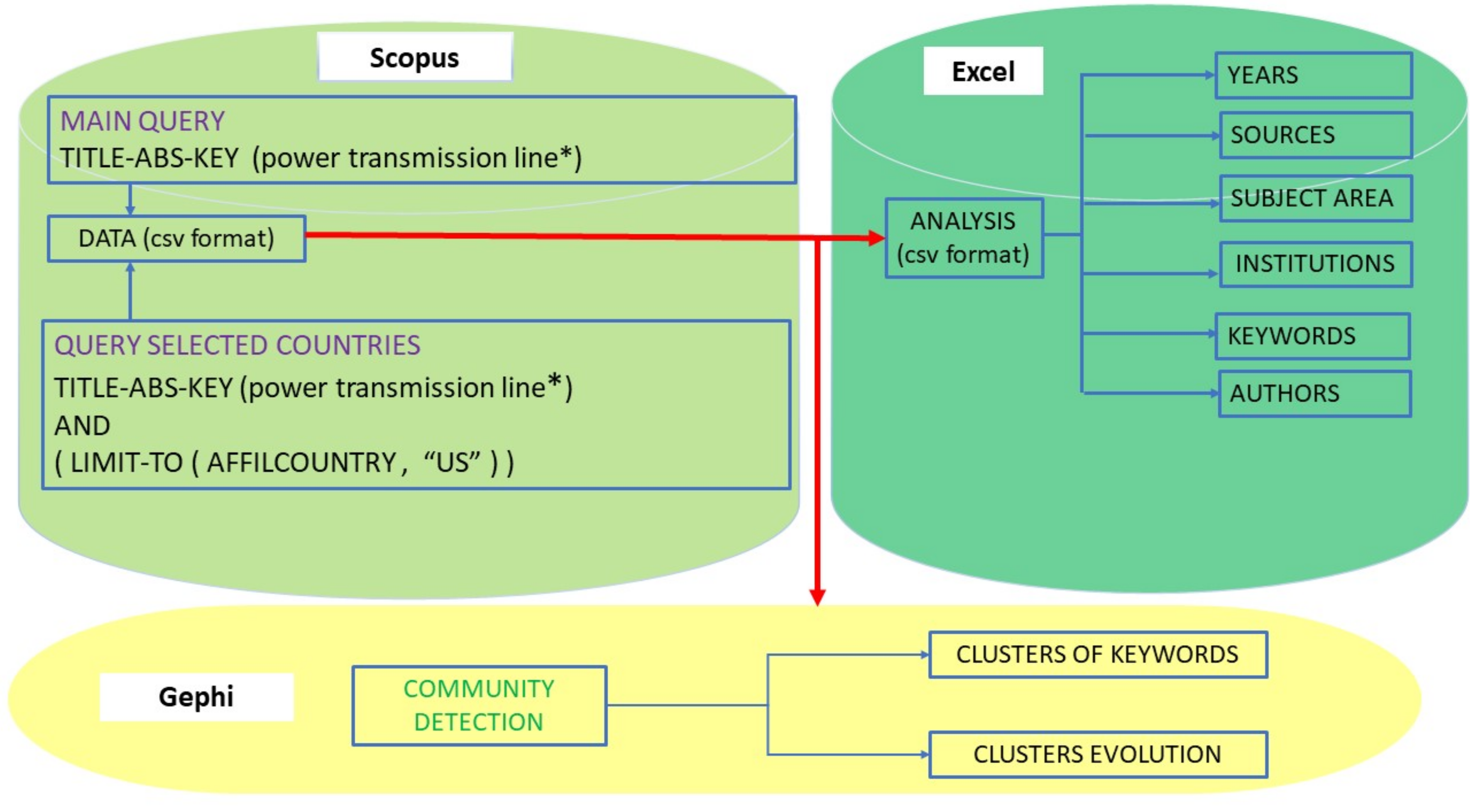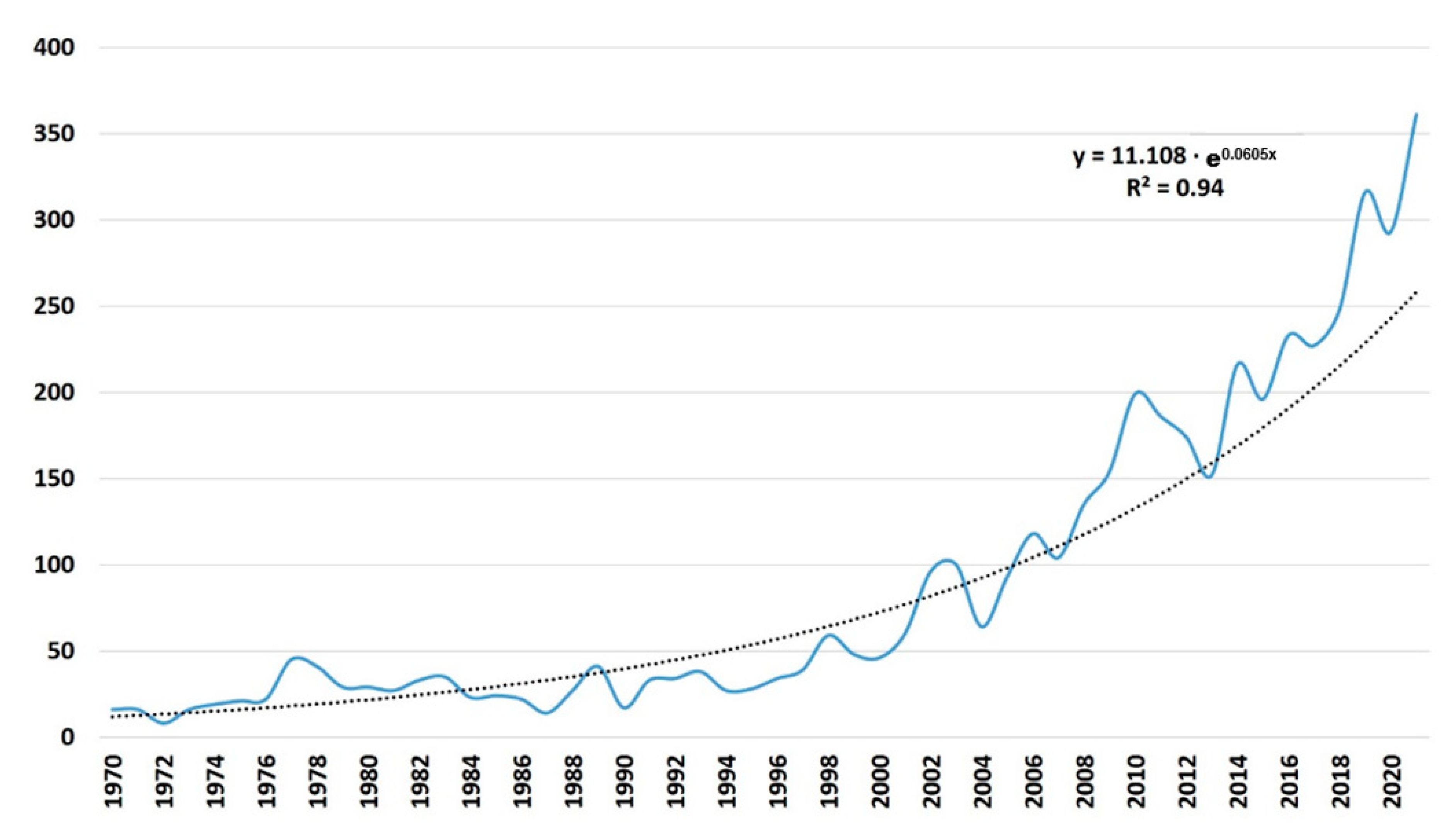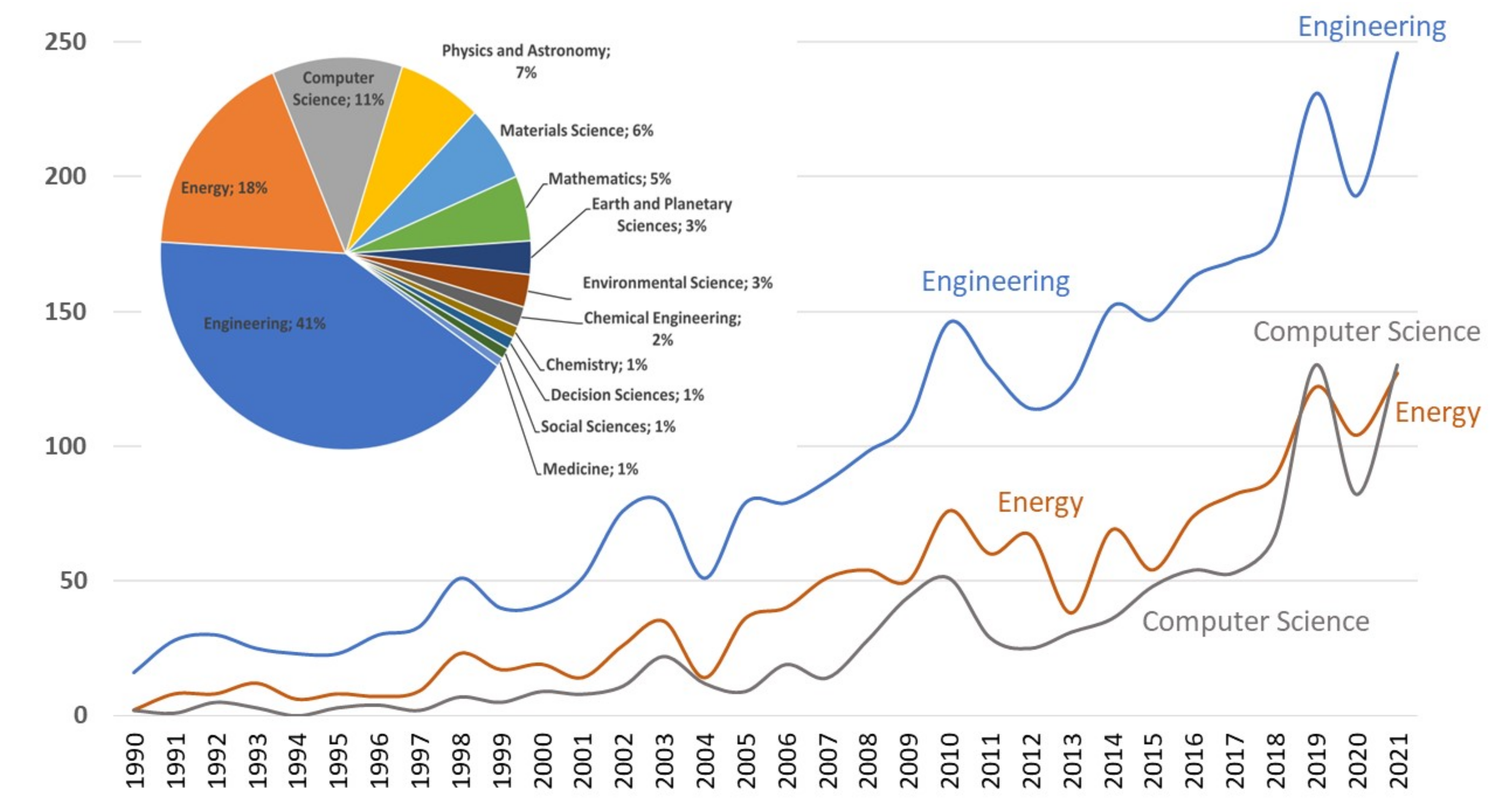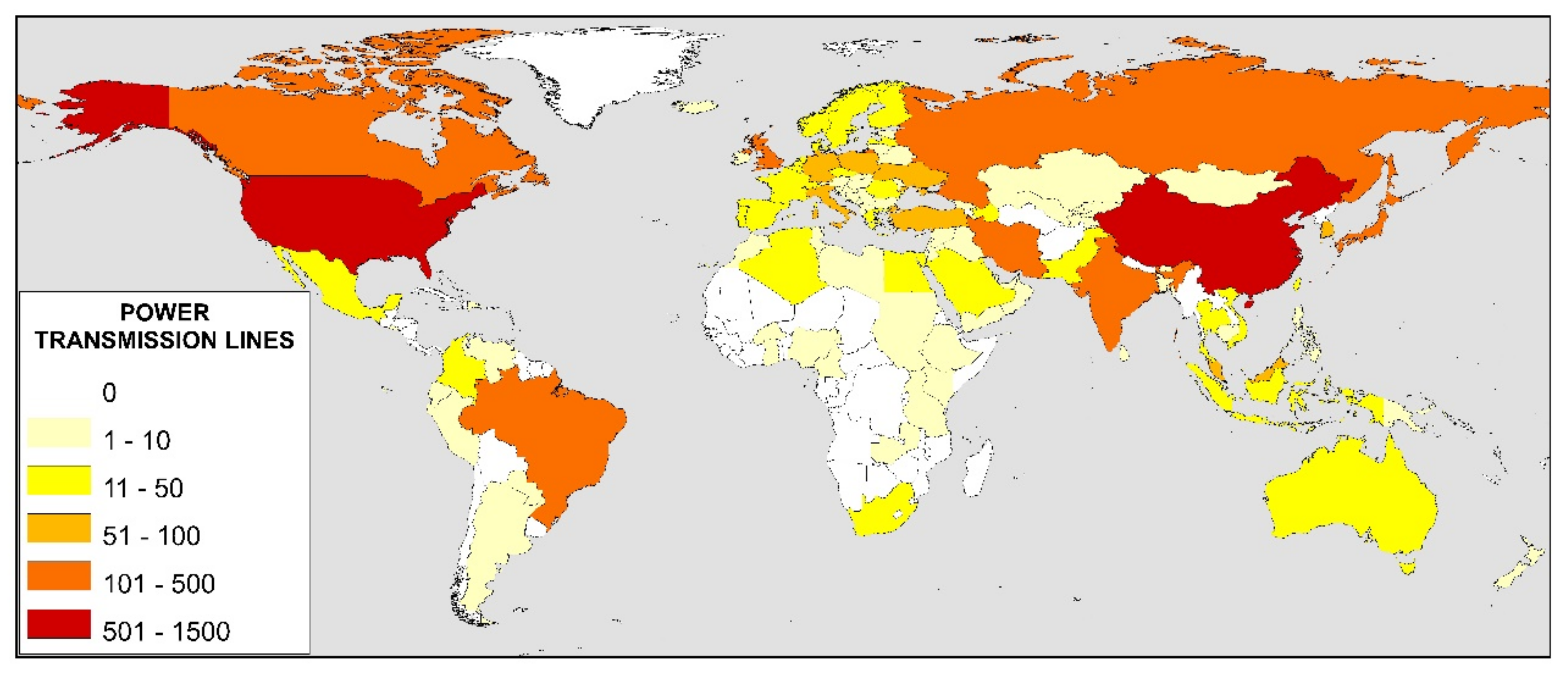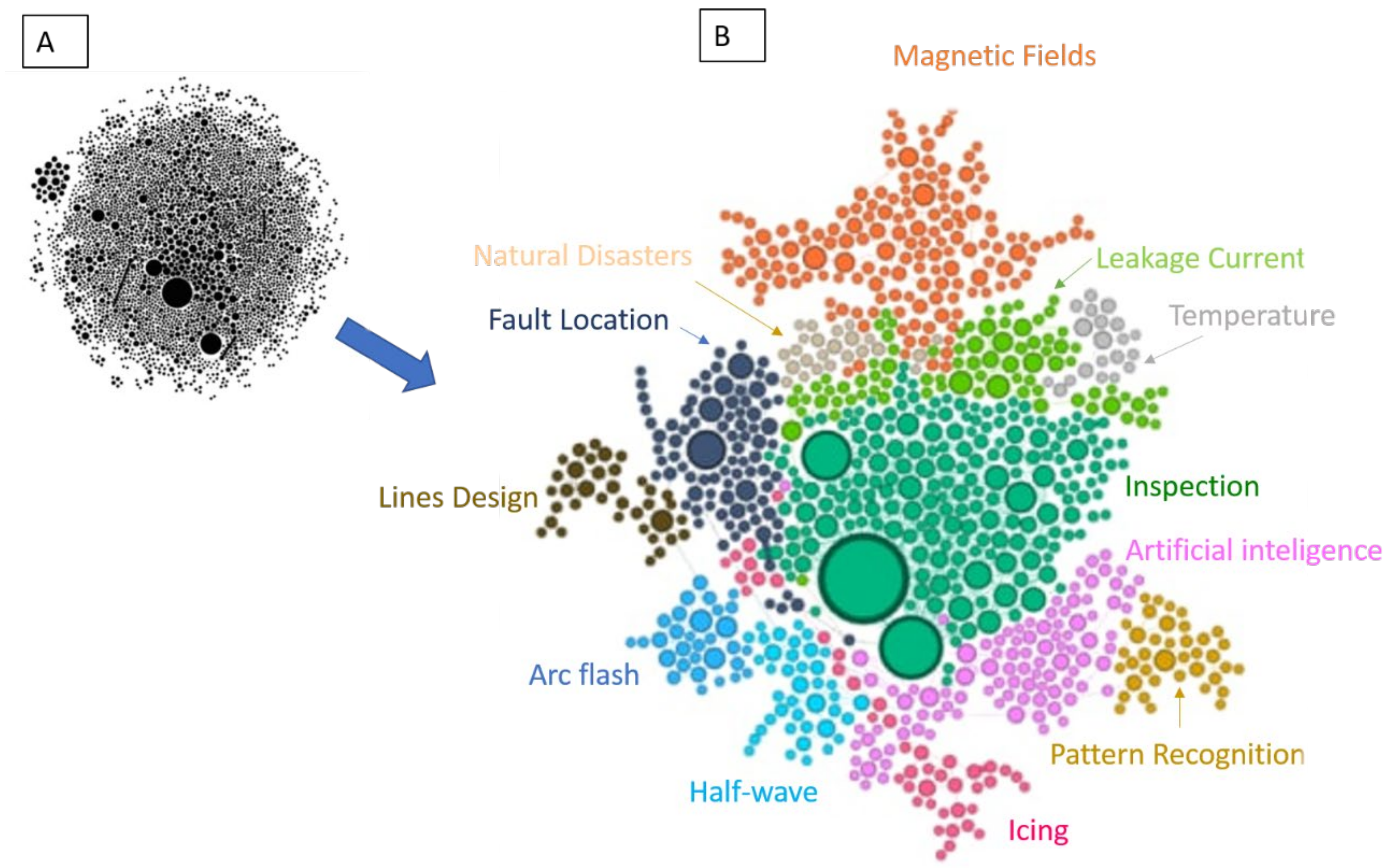1. Introduction
Electric power is the ideal energy variant for the distribution and transport of energy from production to consumption points [
1]. The non-coincidence of the production facilities (renewable or non-renewable) and the consumption centers makes it necessary to transport the generated energy. This transport is carried out with power transmission lines, which can be overhead or underground lines.
A power transmission line can have two different functions, transmission and interconnection, even though in fact they can be found overlapping on the same power transmission line [
2]. It is a power transmission line when it connects an energy production facility with a consumption point, the power in this case always flowing in the same direction and its value varying according to the energy demand of the consumption point [
3]. An interconnection line connects two production centers and therefore the power flowing through the interconnection line may run in opposite directions. In most cases, transmission power lines are of great length, since they usually connect generation plants that may be hundreds of kilometers away from the consumption centers [
4].
Therefore, when transmitting energy, high voltage and low intensity are used so that there are less losses in the wire, since the resistance varies according to the length, and as these lines are very long, the energy losses due to heating would be very high [
5]. The voltage levels used in the transport and interconnection are, for example: Spain (400 and 220 kV), France (400, 225 and 150 kV), England (400, 275 and 150 kV), Germany (400, 220 and 110 kV), Russia (1150, 750, 500, 400, 330 and 220 kV), USA (800, 765, 500, 460, 400, 345, 287 and 230 kV), Canada (735, 315 and 120 kV). In all these countries the frequency is 50 Hz with the exception of the USA, which uses 60 Hz. Energy exchanges between European countries through interconnection lines are due to various causes such as, for example: consumption peak shifts (e.g., France and England) [
6], different structures in the means of production (e.g., Switzerland and Germany, or Switzerland and France [
7]), or differences in hydraulic flows (e.g., between France and Spain) [
8,
9]. In Europe, the transmission voltage is set at 400 kV for the purpose of economic exchanges of electrical energy [
10], since electrical energy cannot be stored in large quantities.
Another of the main lines of research in power transmission lines is the type of structure, where three main types can be distinguished: open or radial, closed or ringed, and meshed. The first type is not very frequent; it is the network with the lowest cost and security index, being used in receiving systems of low power and very low density in terms of reception points. In the second type, the cost is higher than in the radial, but its security is much higher, the installation being assured even in case of faults in the interconnection lines. Finally, the third type is the most complex type, presenting the same advantages as the ring networks, but being the most expensive and the most secure. The latter is therefore recommended when an electrical network has a high density of receivers and the security of supply must therefore also be high, covering areas of high power.
The design of power transmission lines could assume them to be ideal conductors if the lines were short distances long, but in fact the reverse is the case, as the points of power generation are far from the points of consumption. It is important to highlight that there are four physical phenomena to be taken into account, depending on the distance and the voltage: resistive effect, inductive effect, capacitive effect and conductive effect.
The resistive effect, responsible for the heating of the wire and the voltage fall along the transmission line, depends mainly on the material of the wire and its thickness. The inductive effect starts to be considered on transmission lines where the inductive reactance is comparable to the reactive resistance. As the voltage level of the conductors increases, the resistance of the conductors is much lower than the inductive reactance. For example, for a 230 kV transmission line the X1/R1 ratio is 8, or for a 500 kV line it is 14. Note that in high voltage transmission lines the inductive effect is the limiting factor in active power transfer.
The capacitive effect is due to the shunting effect between the conductors, and between the conductors and the floor. This effect is taken into account for lines longer than 80 km. The conductive effect is due to leakage currents due to the insulation, and often due to the environment surrounding the cable. The best known is the corona effect and is taken into account in the selection of high-voltage power line wires.
In the design of the energy transmission, the energy yield must be proportional to the investment costs to be carried out in order to materialize such transmission. Therefore, the loss factor and efficiency must be determined for different types of lines, considering in first approximation that the losses of the line are exclusively Joule losses, which originate in the conductors of the same [
11]. In fact, other losses appear in AC lines, but in principle, the Joule effect losses are still the main ones. From here it is possible to deduce which type of line is the most advantageous. This will be the type of line used to make possible the transport of energy. In this sense, the power lines to be studied are: DC power lines, single-phase AC power lines, and three-phase AC power lines. In addition to losses due to the Joule effect, it is necessary to take into account that there are other losses such as: losses produced by the magnetic field [
12], losses produced by the electric field [
13], or losses as a consequence of the imperfection of the insulating materials [
14].
This manuscript aims to highlight the main global research trends in power transmission lines and to detect which are the emerging areas. The manuscript covers three main aspects. First, the main scientific categories of these publications and their temporal trends are considered. Second, the countries and affiliations that contribute to the research and their main research topics are identified. Third, the main trends in the field are delineated, using the detection of scientific communities by means of the clustering method.
2. Materials and Methods
Of the two main scientific databases, Web of Science and Scopus, it has been proven that in scientific areas they have a 90% overlap and therefore either of them is useful for a bibliometric study [
15]. To achieve the proposed objectives, an analysis of all the scientific publications indexed in the Scopus database was carried out with the TITLE-ABS-KEY search (“power transmission line*”). The search was limited to the period from 1970 to the last complete year, i.e., 2021. This methodology has proven to be useful for the analysis of scientific trends in energy [
16] and other sciences [
17,
18].
Figure 1 shows the sequential methodology used, where, starting from the Scopus data download, data analysis has been carried out with a spreadsheet and a specialized network analysis software, Gephi, has been used. (
https://gephi.org/ (accessed on 1 July 2022)).
With this search query, more than 4600 publications have been found, distributed as shown in
Figure 2 over time. The blue line represents the publications per year, and the dotted line the estimated trend, the mathematical formula of which is shown in
Figure 2. Since 1970 there has been a constant and exponential increase in this subject, reaching more than 50 publications per year in 1998, and 100 in 2003, continuing the upward trajectory until the last year studied reached more than 370 publications.
These publications were written in 24 different languages: English, Chinese, Russian, Japanese, French, Portuguese, German, Polish, Turkish, Spanish, Korean, Persian, Hungarian, Norwegian, Czech, Finnish, Italian, Slovenian, Ukrainian, Afrikaans, Bosnian, Bulgarian, Croatian, and Swedish. The majority were published in the form of journal articles (54%), of which only 1% were review papers. 45% were published in conferences and the remaining 1% in books and book chapters. The high percentage of congresses indicates that this is still a growing research topic.
4. Analysis of Scientific Communities: Clustering
After analyzing all the publications using Gephi software, the results shown in
Figure 5 are obtained. The total number of publications is shown in
Figure 5A, where only the publications that occupy the core are directly related to each other by the related topics, i.e., they form a scientific community or cluster. In
Figure 5B, twelve representative clusters are represented in different colors: Line Inspection, Leakage Current, Magnetic Fields, Fault Location, Icing, Lines Design, Natural Disasters, Temperature, Half-wave, Arc flash, Pattern Recognition, and Artificial Intelligence.
Each country must define how it understands high voltage lines. In Spain, for example, High Voltage Power Lines are understood as three-phase alternating current lines at 50 Hz frequency, whose nominal effective voltage between phases is higher than 1000 V. These high voltage power lines can be either overhead or underground. The specific regulations of each country regulate when periodic inspections must be carried out; in the case of Spain for example, they are every 3 years.
Table 2 summarizes the main keywords of Cluster 0, focused on Power Transmission Line Inspection. It can be understood to have begun in 1989 with the publication of a research study whose ultimate goal was the automation of fault detection in infrared images of power transmission lines [
31]. A few years later, it was proposed to automate the inspection of power transmission line equipment by means of a mobile robot unattended by a human operator [
32]. This line of research has been continued over time by making improvements such as inducing transmission line voltage as a power source for the robot [
33], or obstacle detection [
34,
35]. It can be seen that this cluster, apart from being the most relevant, is the one that occupies the central position and therefore is the point of linkage between other clusters.
Cluster 1 is focused on Leakage Current.
Table 3 summarizes the main keywords of this cluster. Due to atmospheric pollution over the years, especially in developing countries, contamination of high voltage insulators has been a significant constraint to the safe and reliable operation of power transmission lines [
36]. This is closely connected with flashover, understood as an abnormal electrical discharge (as through the air to the ground from a high potential source or between two conducting portions of a structure). For the prediction of contamination flashover, the Leakage Current measurement methods generally use the maximum value of the leakage current pulses, the amplitude of the leakage currents before approaching flashover, and the leakage current RMS values [
37].
Cluster 2 is focused on Magnetic Fields.
Table 4 summarizes the main keywords of this cluster. One of the most studied environmental aspects in relation to energy transport is that of electric and magnetic fields due to the interest and social concern generated by their possible impact on health. An electromagnetic field is an area where electric and magnetic fields exist, created by electric charges and their movement, respectively. This cluster has implications for methods of measuring the electromagnetic field distribution under power transmission lines in real field conditions [
38]. The first publication of this cluster dates back to 1966, describing measurement of the Faraday rotation angle of a laser beam on a flint glass rod. The instantaneous magnetic field adjacent to a transmission wire was obtained, and this was proposed as a current measurement device applicable to a very high voltage power transmission line, greater than 500 kV [
39]. Electromagnetic fields are generated by the movement of electric charges and our body is accustomed to coexist with them. Electrical systems generate extremely low-frequency electromagnetic fields (50 Hz or 60 Hz) and therefore transmit very little energy [
40,
41]. The electromagnetic field of high-voltage power transmission lines is lower than that of commonly used household devices such as TV sets, e.g., mobile phones (close to 1900 MHz) or microwave ovens (from 2400 to 2500 MHz) [
42]. For a reference to the recommended limits, it is possible to look up the I.C.N.I.R.P. (International Commission on Non-Ionizing Radiation Protection) limits (
https://www.icnirp.org (accessed on 1 July 2022)). Within this cluster, the finite element method is widely used [
43,
44]. For example, in the case of Spain. power transmission lines provide maximum values (at the closest point from the ground to the conductors) ranging between 3–5 kV/m for the electric field and 1–15 µT for the magnetic field on 400 kV lines. In addition, the field strength decreases very rapidly as the distance to the conductors increases, being inversely proportional to the square of the distance: at 30 m distance the electric and magnetic field levels range between 0.2–2.0 kV/m and 0.1–3.0 µT respectively, while the levels are usually lower than 0.2 kV/m and 0.3 µT from 100 m distance. The occupational exposure guidelines of the International Commission on Non-Ionizing Radiation Protection (ICNIRP) are 10 kV/m for electric and 100 μT magnetic fields for 400 kV over-head power transmission lines. Specialized studies in Finland find values close to this recommendation only in some 400 kV substations, but always with lower values [
45] for the magnetic fields. One study in Libya shows values of 8.3 μT (double circuit 1 m above ground and Io = 215 A), and 38.6 μT (double circuit 4 m above ground and Io = 1000 A) [
46].
Cluster 3 is focused on Fault Location.
Table 5 summarizes the main keywords of this cluster. A fault is an undesired short-circuit contact between two wire phases or between a wire phase and the ground [
47]. There are different types of faults that occur suddenly, such as those caused by the force of nature, mechanical, caused by animals, etc. Transmission line faults often generate serious economic losses and social problems. The more accurate the detection and fault location that has been achieved, the better the task of inspection, maintenance and repair of the line can be accomplished. Rapid service restoration could decrease customer claims, outage time, lost revenues, and staff repair costs. All of these issues are becoming more and more important to investors [
48]. There are different methods that are used for the location of faults in transmission lines, e.g., the superposition principles such as Fourier transform [
49], Laplace transform [
50], or wavelet transform [
51], methods based on single-end measured data. To improve the location of faults calculation, many authors proposed to use the information from both ends of the line (Two-end Measurement) [
52]. Recently, modern computational techniques have been implemented to assist in these research studies, such us Artificial Neural Networks [
53].
Cluster 4 is focused on Transmission Line Icing.
Table 6 summarizes the main keywords of this cluster. The icing of overhead power lines is a huge problem for electric utilities. Charges resulting from frozen conductors depend on icing thickness. Some authors have investigated image recognition to study icing thickness [
54]. Therefore, the transmission line designer must take into account the specific location and risk of frost and then establish the performance levels of the transmission lines to be constructed within his location [
55]. Some authors claim that it is possible to find more than thirty techniques of de-icing in different stages of development that may ensure protection against ice [
56]. Studies that employ modern mathematical techniques to establish predictive models stand out [
57], e.g., Deep Learning [
58] or BP Neural Network [
59].
Cluster 5 is focused on Overhead Power Transmission Lines Design.
Table 7 summarizes the main keywords of this cluster. This cluster is mainly linked to the fault location and icing clusters. One of the main issues of this cluster is the cost of the line itself [
60]. The main design codes of all the main countries can be accessed online [
61], including: design loads and philosophies, transmission structures, conductor design and behaviour, foundations, and construction. The environmental constraints of overhead power lines and possible solutions have been under consideration for the design of these lines [
62,
63].
Cluster 6 is focused on Transmission Lines and Natural Disasters.
Table 8 summarizes the main keywords of this cluster. This cluster is linked to those of fault location, leakage current, and magnetic fields. The main lines of research are linked to prediction [
64] and the resilience or ability of the lines to resist natural disasters [
65]. The natural disasters analyzed are of very diverse nature: typhoon [
66], tornado [
67,
68], earthquake [
69,
70], ice storm [
71,
72], lightning [
73,
74], wind/rain [
75,
76], or wildfire [
77,
78].
Cluster 7 is focused on Temperature.
Table 9 summarizes the main keywords of this cluster. This cluster is linked to the Leakage Current cluster. The ambient temperature affects the laying of power lines as the wire tensions depend on it. On certain occasions, special lengths are chosen depending on the geometry and the dilatation of the wire [
79]. Therefore, transmission line modeling is one of the major concerns of this cluster based on temperature, such us load current [
80], or under fluctuating power flows [
81]. These studies sometime include Remote Sensing techniques us aerial LiDAR survey [
82], or an infra-red sensor [
83].
Cluster 8 is focused on Half-wavelength Power Transmission Lines and linked with arc flash and icing clusters.
Table 10 summarizes the main keywords of this cluster. When the power generation station and the places of consumption are very far apart, extra-long distance transmission projects (as thousands of kilometers for example), this technical solution (half-wave length lines (HWLLs)) is used to transport electrical power. It is considered the only transmission technique that does not require sophisticated equipment either at the line terminals or at the intermediate points [
84]. Half-wavelength transmission line is a type of three-phase AC transmission in which the length of the line between its transmitting and receiving ends is approximately half the wavelength (i.e., 3000 km for 50 Hz). In the specialized literature, Wolf and Shcherbachev were the first to study this method in the Soviet Union [
85]. These power transmissions are typically used for UHV (Ultra-High Voltage) voltages in the range of 800 kV to 1200 kV. This approach was proposed for both AC [
86] and DC [
87] systems. Some authors propose a fault location method for HWTLs in order to ensure safe and reliable operation [
88]. Nowadays, some authors analyze the infeasibility of this approach [
89].
Cluster 9 is focused on Arc flash.
Table 11 summarizes the main keywords of this cluster. The electric arc can be defined as the phenomenon caused by electrical wires, which consists of the ionization of the air when the electrical resistance of the air is overcome; and it happens when there is a very high electrical tension (voltage). According to experts, it is visible at a level higher than 30,000 volts. Arc faults happen when there is a high voltage in a circuit gap or break in the circuit [
90]. Research on secondary arcs is led by studies such as “Arc effect on single-phase reclosing time of a UHV power transmission line” [
91] or “New approach to adaptive single pole auto-reclosing of power transmission lines” [
92]. Almost 80% of high-voltage power transmission line faults in interconnected power systems are intrinsically transient [
63]. Even so, many studies focus on distinguishing whether the type of fault is a transitory fault or a permanent fault [
64]. Other main lines of research focus on algorithms for arc fault (transient) recognition and dead time determination for adaptive auto reclosing [
93,
94]. This cluster is close to that of the line design cluster and the half-wave clusters. Line designers must determine the worst-case scenario, since voltages during this type of fault depend on many parameters, such as the location of the fault, or the load prior to the fault [
95].
Cluster 10 is focused on Mathematical Pattern Recognition and is very close to the IA (Artificial Intelligence) cluster.
Table 12 summarizes the main keywords of this cluster. The use of mathematical morphology (MM) in the energy system is a relatively recent analysis technique [
96]. Mathematical morphology is developed from set theory and integral geometry, and gets its name because it deals with the shape of signals. In contrast to the Fourier transform or the wavelet transform, which extract the frequency information in the signals, it is called MM because it deals with the shape of the signals [
97]. The other technique most commonly used in the in the transmission line faults is the Wavelet Transform [
98,
99]. Pattern Recognition is important in transmission line fault recognition and classification [
100,
101]. Note that ATP (Alternate Transients Program) is a software tool that allows the digital simulation of transient phenomena of an electromagnetic and electromechanical nature for the purposes of design, equipment specification or definition of electrical parameters. So, ATP is used for checking algorithms for accurate fault location [
102,
103].
Cluster 11 is focused on IA (Artificial Intelligence).
Table 13 summarizes the main keywords of this cluster. Artificial Intelligence is a special field of computer science that aims to emulate human logic in a computer. AI systems are powered by algorithms, using techniques such as machine learning and deep learning to demonstrate “intelligent” behavior. Artificial Intelligence can be classified into two main categories: functionality-based and capability-based. Machine learning is the process by which computers acquire pattern recognition, or the continuous ability to learn from data and make data-based predictions, and can make improvements without being specifically programmed to do so. Deep learning is a current subset of machine learning that has proven to perform significantly better than some traditional machine learning approaches. Therefore, this cluster uses IA techniques for fault detection [
104], location [
105], diagnosis [
106], and classification [
107]. One of the most promising IA techniques is machine learning, which has shown to be useful for detecting and predicting the types and locations of faults on a 750 kV, 600 km long power transmission line [
108].
5. Discussion
Once all documents had been analyzed in relation to power transmission lines, the strong leadership of China’s institutions in this field was observed, with the top ten institutions leading in this field of research. These were: China Electric Power Research Institute, Chinese Academy of Sciences, North China Electric Power University, Tsinghua University, State Grid Corporation of China, Xi’an Jiaotong University, Chongqing University, Wuhan University, University of Chinese Academy of Sciences, Shenyang Institute of Automation Chinese Academy of Sciences. The first institution listed from the USA was the Georgia Institute of Technology, and the first for Russia was Kazan State Power Engineering University. The latter two institutions have half the number of publications of China’s tenth institution.
The scientific categories are an important reference to the area of knowledge in which the research is being conducted. The three main scientific categories found were Engineering, Energy and Computer Science. The first category has always led this scientific field. But as for the second place previously held by the Energy category, the trend shows that in recent years it is being replaced by the Computer Science category. This is certainly due to the importance of issues related to Pattern Recognition or Artificial Intelligence.
From the analysis of the scientific communities, twelve clusters have been detected, which are the research trends in this scientific field. These are: Line Inspection, Leakage Current, Magnetic Fields, Fault Location, Icing, Lines Design, Natural Disasters, Temperature, Half-wave, Arc Flash, Pattern Recognition, and Artificial Intelligence.
Table 14 shows the order of relevance by the number of publications for each of the clusters. The main cluster is Power Transmission Line Inspection, which also has a central place in all of these publications. It is surrounded by the clusters of Temperature, Leakage Current, Fault Location, Natural Disasters, and Artificial Intelligence.
The second most important cluster is the Magnetic Fields cluster. This cluster is linked to the other research clusters through the Leakage Current and Natural Disasters clusters. The third most important cluster is Artificial Intelligence; as has been discussed this is a cluster related to computer science. This cluster is linked to the central cluster for Line Inspection, and to the Icing cluster, but above all, it acts as a link to the Pattern Recognition cluster, which is separated from the rest except for the link to this Artificial Intelligence cluster.
The fourth cluster is focused on Leakage Current. This cluster is linked to Line Inspection on the one hand, and Temperature, Natural Disasters and Magnetic Fields on the other. The fifth cluster, Fault Location is linked to the Natural Disasters, Lines Design, Icing and Inspection clusters. The sixth cluster is the one focused on Icing. It is also a very transversal cluster, and it is mainly related to those of Artificial intelligence, Half-wave, Arc Flash, and Lines Design. The seventh cluster is focused on Lines Design. This cluster is only linked to Fault Location. The eighth most important cluster is the one focused on Mathematical Pattern Recognition, and it is linked to the rest of the publications only through the Artificial Intelligence (AI) cluster. These two groups, as mentioned above, are the result of the computer science facet of this field of research.
The ninth cluster is focused on Half-wave. This cluster is related only to three others, mainly Arc Flash and Artificial Intelligence, and to a lesser extent to Icing. The tenth cluster focuses on Natural Disasters. This cluster is closely related to three other major clusters, Fault Location, Magnetic Fields and Leakage Current. The eleventh cluster is so little linked to the centre of the publications, one can only understand the relationship with the Line Design and Half-wave clusters. Finally, the twelfth cluster is the Temperature cluster, which can be considered together with the Leakage Current cluster.
In summary, three very cross-sectional clusters have been found: Icing, Leakage Current, and Artificial Intelligence. In addition, it has been observed that Pattern Recognition is an upcoming line of research, which is emerging and establishing its own identity separate from the Artificial Intelligence cluster.
6. Conclusions
In this study, all scientific publications related to power transmission lines have been analyzed. As is well known, electricity transmission is carried out at high voltages in order to transport electricity with the lowest possible energy losses. In general, the power transmission network is meshed, which means that all the points are interconnected and that, if an incident occurs somewhere, the supply is guaranteed since the electricity can arrive from another power transmission line. In addition, the transmission grid is remotely controlled, i.e., faults can be detected and isolated from the control center.
The three main categories in which these research papers are grouped are, first Engineering with 41% of the total, followed by Energy and Computer Science. Although it should be noted that the latter, Computer Science, has already surpassed Energy in the last year in terms of the number of annual publications. The great leader in this scientific field is China with 25% of the total number of publications, followed by the USA with 4 times less and then Russia. Thus, it is not surprising that the top 10 affiliations are from China. The three main affiliations are: China Electric Power Research Institute, Chinese Academy of Sciences, and North China Electric Power University. All affiliations have research related to 6 main keywords: Electric Lines, Power Transmission, Electric Power Transmission, Transmission Line Theory, Inspection, and Robots, with a strong emphasis on Robot Inspection.
The analysis of global research trends, based on the analysis of the clusters that make up the total number of publications, shows 12 clusters, of which the three main lines of research are in this order: Power Transmission Line Inspection, Magnetic Fields, Artificial Intelligence. The latter is the one that is emerging strongly in recent times and is what makes the scientific field of computer science so relevant within this discipline. The second research lines are those focused on: Leakage Current, Fault Location, Icing, and Lines Design. Finally the third block of clusters, which have fewer publications are: Pattern Recognition, Half-wave, Natural Disasters, Temperature, and Arc flash. As in the main cluster group, there is one cluster focused on Computer Science, which in fact is closely linked to Artificial Intelligence, and seems to be a singularity of one, namely Pattern Recognition.
